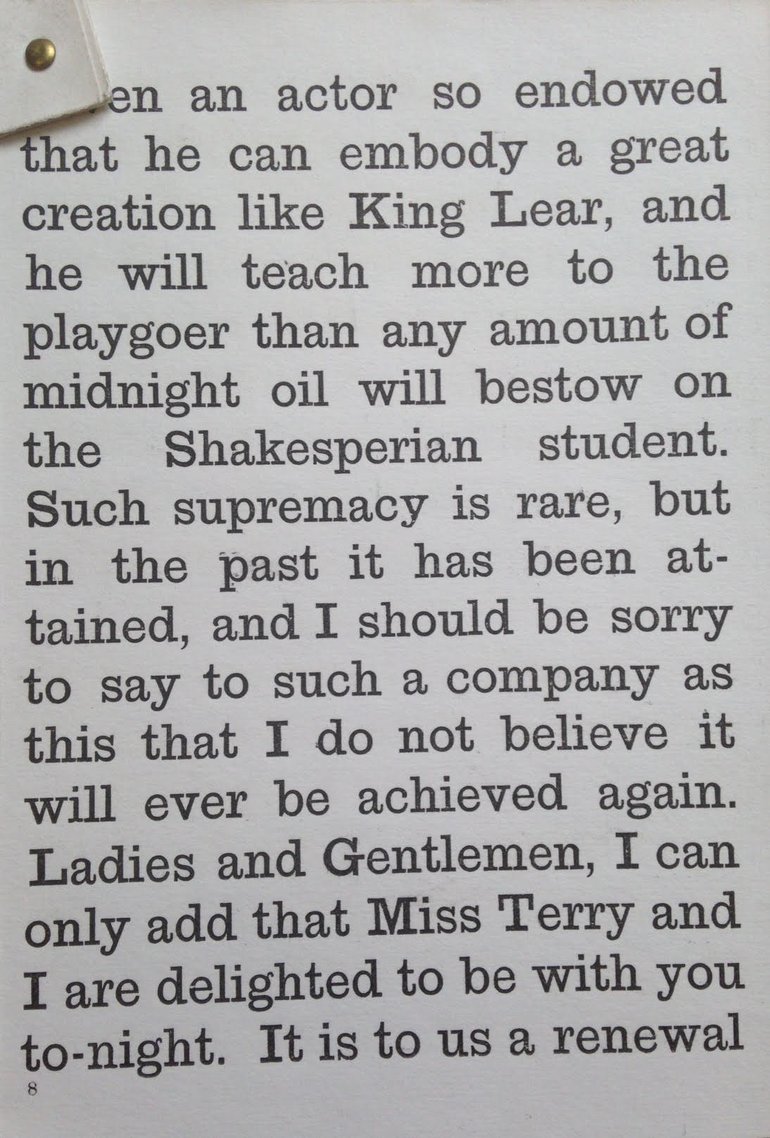Alexander Thom is an AHRC-funded PhD student at the Shakespeare Institute, working with the Birthplace Trust as a Research Advocate for Midland 3 Cities Doctoral Training Partnership.
This blog post is part of a series of responses to discoveries made in the SBT Collections, concerning the afterlives of Shakespeare’s King Lear. In previous posts I have looked at playbills and Tate’s Restoration adaptation of Lear. In this post, I want to explore the interactions of afterlives, in order to show how different mediums inform one another, in turn influencing how audiences experience the play in their time.
I was looking at the remarkably rich Bram Stoker collection, which has made available a considerable amount of material regarding the prominent Victorian actor, Henry Irving (1838-1905). Focusing on the years in which I knew that Irving had planned and performed King Lear, I sifted through his correspondence, lectures, speeches, and other documentary evidence for insights. One notable comment he made was in an address delivered to the fabulously named Philothespians’ Club (trans. ‘lovers of actors’) in 1892:
"An actor so endowed that he can embody a great creation like King Lear [...] he will teach more to the playgoer than any amount of midnight oil will bestow on the Shakespearian student." (9/63)

As a Shakespearian student who expends a fair share of midnight oil, I fervently hope he is wrong. Nevertheless, the illuminating impact of a great actor is beyond dispute. Scholarship, however, can often teach us surprising and interesting things. On occasion, we can even provide insights into how great actors arrive at their dramatic visualisations.
Irving’s Lyceum productions were famous for their sumptuous designs and spectacular set-pieces. As I looked over Irving’s programme for his 1892 production of King Lear at the Lyceum Theatre, a detail regarding this caught my eye (bottom right):
The Scenes of Lear’s Palace and Gloster’s and Albany’s Castles are from designs by FORD MADOX BROWN.

Ford Madox Brown (1821-1893) was a significant but relatively unappreciated artist and designer, best known for his association with the Pre-Raphaelite Brotherhood. He taught and guided painters like Dante Gabriel Rossetti. He was also known by his contemporaries for his pride, periods of dark melancholy, and his isolation. When his eldest son died suddenly in 1874, Brown dedicated a room in each of his subsequent homes to Oliver’s memory, filling it with his books and belongings, as a shrine to his loss. In later years, Brown committed himself to addressing the social issues of the day, especially with regards to the houseless poverty of Manchester. He even founded a labour bureau there in 1886. With this brief biography in mind, I found it touching that Brown, as the scholar Helen Borowitz has shown, developed a lifelong preoccupation with King Lear — painting and re-painting scenes from Shakespeare’s tragedy. To some extent, he seemed to recognise that life can imitate art, and at times his art imitated this aesthetic understanding of his own life.
As a marker of his preoccupation with Lear, whether intentional or not, we can detect a certain visual identification between Brown’s 1877 self-portrait and his earlier Cordelia’s Portion.


This painting of the first scene of King Lear was one of many that Henry Irving used to design his production. It is unclear how well Irving knew Ford Madox Brown or of his strong personal attachment to the play. In 1892, when Irving decided to adapt Brown’s paintings to the stage, Brown was in extremely poor health — he would die the following year. Similarly, I have no clues so far as to what Brown thought of Irving’s production or even whether he saw it. (A future research project perhaps.) What we do know is that Irving followed Brown’s work on Lear, including Cordelia’s Portion, very closely. We can see this in the following image of Irving as Lear for The Illustrated London News in November 1892.

The overall similarities between the composition of this picture and Brown’s design for Cordelia’s Portion are obvious. But it is the subtle details here that are especially telling: the branches above the throne (perhaps laurels, for their Apollonian significance), the circular side-table with the cone and orb, the design of the sceptre, and so forth. The influence of Brown here is indisputable and, both here and elsewhere, his vision frames a number of the production’s most significant set-pieces.
It is this interplay between the two mediums that I find particularly fascinating. Brown was thoroughly unappreciated in his own time, not least because he was proud and responded poorly to criticism — a Lear-like trait in itself. Yet, his artistic responses to King Lear, perhaps born of this identification, formed an aesthetic vision of the play that influenced thousands of audience members, in spite of his relative obscurity.
To return to Irving’s speech to the Philothespians’ Club, we can see that, to “embody a great creation like King Lear,” Irving leaned on Brown’s works for inspiration. In this sense, the artist illuminated the actor, in order for the actor to illuminate the audience. To steal the last word, I might say that an additional contribution to this intellectual commerce occurs with the Shakespearian students and their midnight oil, who may at least retrieve and illuminate such compelling aesthetic exchanges.
In my next blog post, I’ll be reflecting on my time with the SBT Collections, my project more broadly, and the next steps for the research discussed in this series.
